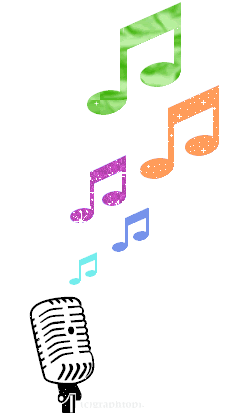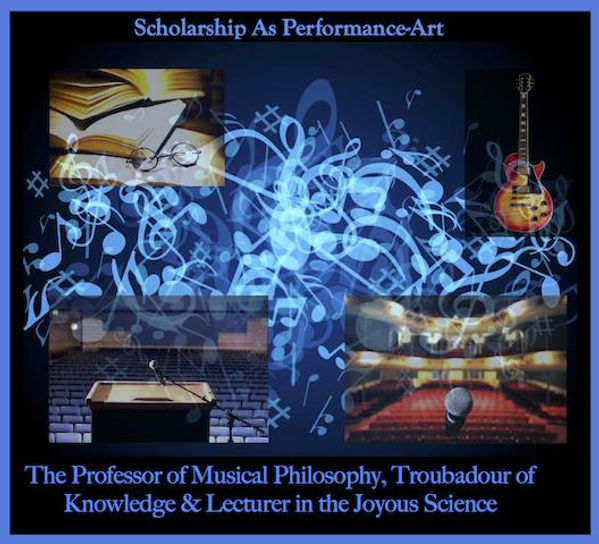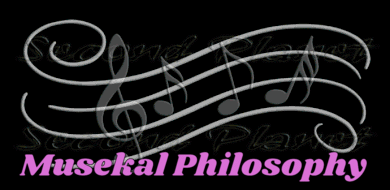


to
Re-Vision Radio's
.

.

.
Program airs on KSQD
90.7-fm / ksqd.org
Mondays 12 to 3 a.m.
Program Guide page,
with your host
The Gypsy Scholar & Bohemian Essayist
(a.k.a. DJ Orfeo ~"Radio Master of Ceremonies").
Broadcasting in Exile
from the TOWER of SONG
—""SOMEWHERE ELSE" RADIO—
and featuring the
Orphic Essay-with-Soundtrack.
.
This page is to aid listeners to “see what I mean” by the TOWER of SONG (both cognitively through the ideas and visually through the thematic images).

.






Troubadour of Knowledge: “a man so empowered by the spirit of knowledge that he invites miracles" (or miraculous synchronicities of Argument & Song).

.
Note: The "Gypsy Scholar,” as a radio handle, isn't meant to claim the host of this program is a professional scholar; only an amateur scholar (with an advanced degree) working in radio as a “public intellectual,” who aspires to Orphic Scholarship. In a similar way, the Tower of Song is not from the Ivory Tower, but from “that tower down the track.”
“I embrace the common, I explore and sit at the feet of the familiar, the low.”
“The office of the scholar is to cheer, to raise and to guide men by showing them facts amid appearances. He plies the slow, unhonored, and unpaid task of observation.”
“Ah ye old ghosts! ye builders of dungeons in the air! why do I ever allow you to encroach on me a moment; a moment to win me to your hapless company? In every week there is some hour when I read my commission in every cipher of nature, and know that I was made for another office, a professor of the Joyous Science, a detector & delineator of occult harmonies & unpublished beauties, a herald of civility, nobility, learning, & wisdom; an affirmer of the One Law, yet as one who should affirm it in music or dancing, a priest of the Soul yet one who would better love to celebrate it through the beauty of health & harmonious power.”
~ Ralph Waldo Emerson
“One must have at disposal all valid results of scholarship, yet one must not be a scholar.” ~ Panchatantra





.
The Mercurial Tower of Song
is now ascending over the horizon—broadening your radio horizon—from the “Invisible Landscape” on the banks of the Neptunian
River of Dreams
in the Middle of the Night
“I know I'm searching for something
Something so undefined
That it can only be seen
By the eyes of the blind
In the middle of the night.”
(Billy Joel, "The River of Dreams")
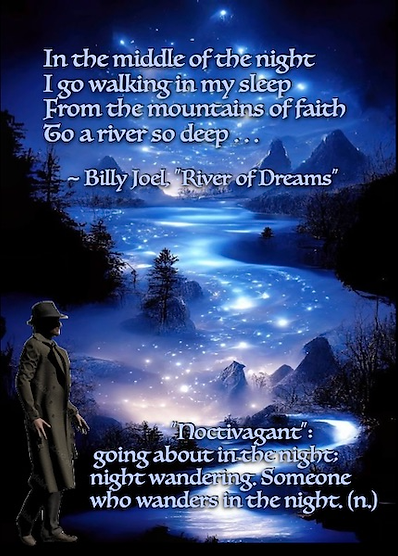

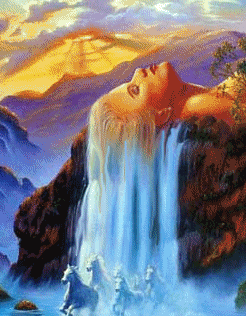

The River of Dreams
.jpg)

.
.
See What I Mean by "That Tower Down The Track"



.

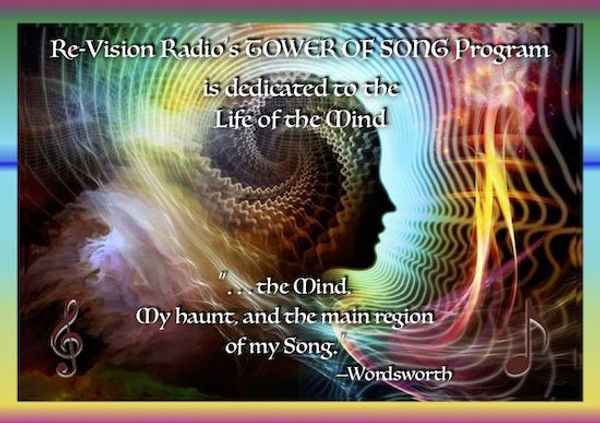
Re-VisionRadio’s Tower of Song, as a type of “underground radio,” is a "Soul-making" program from the "invisible landscape,” and thus "Somewhere Else" Radio. And that "somewhere else" for which we long—"My haunt" (W.W.) or "My retreat and view" (V.M.)—is (in the GS's idiom) the TOWER OF SONG.
“… Initiation into depths, but also into longing, and this will not, should not, ever cease. This longing keeps us in proximity to our souls. It reminds us, as we conscientiously go through the obligations and activities of every day, that there is a place, a "somewhere else" where we also belong and need to go to from time to time. We are reminded of this place by a sentence we read in a newspaper, a picture on a subway wall, a memory brought to life by a smell, [a piece of dialogue from a movie that speaks to us, a beautiful face that haunts our dreams, a passage from a book taken randomly off the shelf] or by a song we hear on the radio." ~Jan Bauer
.
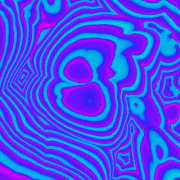
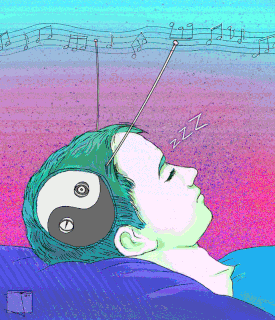

.
RE-VISION RADIO’s TOWER OF SONG, hosted by the Gypsy Scholar & Bohemian Essayist, is a Musical & Philosophical-Literary program dedicated to the "life of the mind.” Because Philosophy is (according to Plato) a form of “play”—an artistic endeavor—, it has the possibility of making the student of philosophy a kind of artist, an "Orphic Scholar," who is distinguished by his or her ability “to play with knowledge and create a collage of ideas or intellectual mind-jazz.” Thus the Gypsy Scholar converts conventional scholarship into scholarship as performance art (what William Blake called "Mental Studies & Performances" of "Argument & Song")—not from the Ivory Tower but from “that tower down the track,” the Tower of Song.
Through his Orphic Essay-with-Soundtrack, the Gypsy Scholar presents a Musekal Philosophy, discovering the music in ideas and the ideas in music; a philosophy that is musical and, conversely, a music that is philosophical. The Gypsy Scholar 's scholarship as performance art is designed to make academic philosophy sound more musical, so that popular music will sound more philosophical. Thus, in the TOWER OF SONG, philosophical essays in the form of the Orphic Essay-with-Soundtrack and the thematic images (on the Tower of Song website) aspire to the condition of music; to the condition of music translated into words.
“Here we have demonstrated the one possible relationship between poetry and music, word and tone: word, image, and idea seek a metaphorical expression analogous to music and now feels in itself the power of music. In this sense we can distinguish two main streams in the history of the language of the Greek people: language which imitates appearance and images and language which imitates the world of music.” ~Nietzsche. The Birth of Tragedy Out of the Spirit of Music.
.
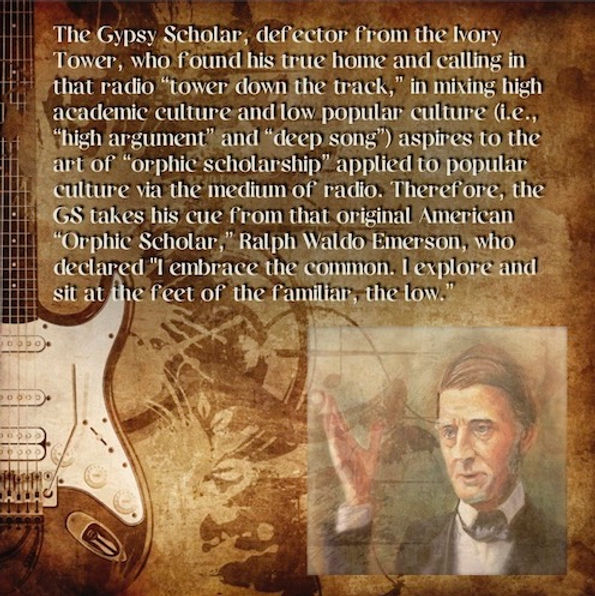
.
The "Orphic Scholar," Ralph Waldo Emerson, essayist and poet, proclaimed he was "a professor of the Joyous Science" (of the 12th-century Troubadours).
.
.


.
Program Description
RE-VISION RADIO’s TOWER OF SONG, hosted by the Gypsy Scholar & Bohemian Essayist, is a Musical & Philosophical-Literary program dedicated to the "life of the mind" and broadcast—"in the middle of the night"—from an imaginal window on your radio dial, 90.7-fm, KSQD. The Tower of Song "music'" program is an eclectic, free-form radio program (looking back to Sixties "underground radio") that falls between the cracks of traditional radio formats, with either "information" or "music" programs. Combing the two formats, the program seeks to both inform/educate and entertain. The Gypsy Scholar, practicing "scholarship as performance art" in a rhapsodic (rhapsōidia) way, presents his Orphic Essay-with-Soundtrack which, in mixing (or rhapsodically stitching together) the spoken word with music (Argument & Song; high argument with deep song, high academic culture with low popular culture), allows the Gypsy Scholar to "rave on words on printed page." This dialectical relationship between Argument & Song means that the prose essay contributes gravitas to popular song and, alternatively, popular song gives wings to the essay, composing a Musekal Philosophy by way of the Orphic Essay-with-Soundtrack. (The use of music in the essay follows the approach of Brecht, whereby the songs comment on themes and issues of the play. This is achieved by placing songs at strategic points in the essay, which serve to punctuate and sum up the preceding discourse and, moreover, to emotionally drive the noetic meaning of the essay's ideas home.) However, in mixing and remixing Argument & Song (highbrow academic culture with lowbrow pop-culture), the program comes to listeners not from the Ivory Tower but from "that tower down the track"—the Tower of Song (located in Squid Row). The Gypsy Scholar has discovered that the Tower of Song program is in line with the recent academic reformist movement called "Re-enchanting The Academy," which has as one of its functions "Not to explain the World but to Sing it" (enchant: from in + cantare, to sing). Because the concept behind the Tower of Song program is Re-Vision Radio, it means that this "music" program is (like the "concept" rock album) a "concept" radio program, featuring the Orphic Essay-with-Soundtrack (conceptual: "unified by a theme, which can be instrumental, compositional, narrative, or lyrical"). Thus, it's a program that deals in Ideas—the ideas in music and the music in ideas. In this sense, because of the Orphic Essay-with-Soundtrack, it's a "music" program that doesn't just play songs—it showcases songs; con-text-ualizes them so that listeners will hear familiar songs in a new way. And the Orphic Essay-with-Soundtrack also means that there’s an essay waiting to be unpacked in a song and, conversely, a song waiting to be evoked out of an essay. The concept of Re-Vision Radio means that the Tower of Song program is (a) radio itself seen in a different way (re-vision) and (b) radio designed in an audio-visual way (vision). Thus, the Tower of Song website is an integral part of the broadcast, with thematic images that are synergistic with the Orphic Essay-with-Soundtrack. Re-Vision Radio's Tower of Song program looks back in a new way to old-time radio—radio as "Theater of the Imagination"—, making Re-Vision Radio the alternative radio concept that lets you see what it means. Therefore, the goal of the Gypsy Scholar's "music" program is to transport its listeners, "in the middle of the night," into that great architectural "acoustic space" of song—the TOWER OF SONG.
“Oh let my Lamp at midnight hour / Be seen in some high Lonely Towr, / Where I may oft out-watch the Bear, / With thrice great Hermes.” (Milton)
"In the lonely, dead of midnight / In the dimness, of the twilight / By the streetlight, by the lamplight .... / And I'm workin', on the insight." (Van Morrison)
.

For full program description, "Re-Vision Radio Manifesto & Visionary Recital," click on image.
.
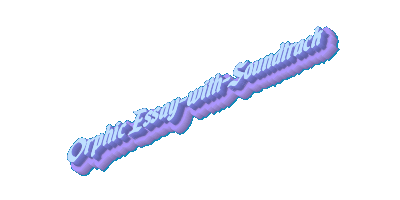
.
.


.
The Gypsy Scholar & Bohemian Essayist (a.k.a. DJ Orfeo, "Radio Master of Ceremonies")--with a flower in one hand (or name) and a sword in the other--is tied to this table and paying his rent every day by broadcasting (in his capacity of "Minister of Information & Popular Culture" for the Romantic "Visionary Company"and "Ringers in the Tower") in exile from the Ivory Tower to "that tower down the track"--the Tower of Song.
"And twenty-seven angels
From the Great Beyond
They tied me to this table
In the Tower of Song . . .
And I'm paying my rent every day
In the Tower of Song."

.
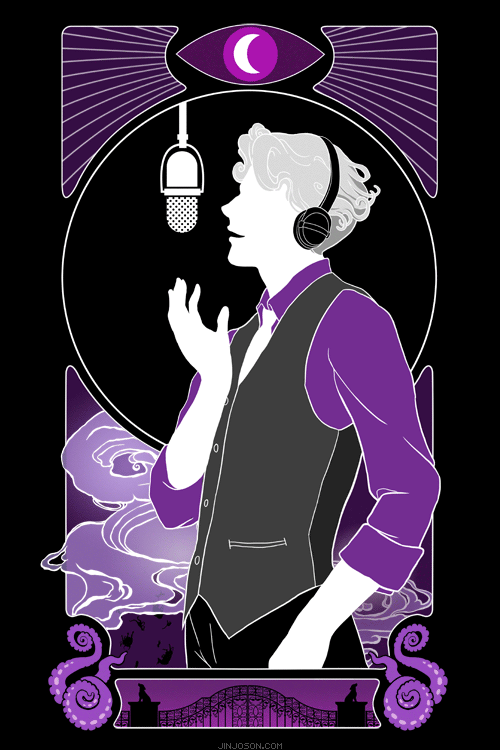
Broadcasting at the midnight hour, the Gypsy Scholar would remind his listeners that there’s a place other than the one of our daytime routine —a “somewhere else”— , where we secretly long to be and need to go to from time to time. The Gypsy Scholar knows “that we are reminded of this place by a song we hear on the radio” [thank you Jan Bauer] and that we can go there through the gateway of song we hear on the radio. In the Gypsy Scholar's lexicon, that special “place,” that “somewhere else” is none other than the Tower of Song.
Therefore, goal of the Gypsy Scholar’s Orphic Essay-with-Soundtrack goes beyond just listening to a song; the goal is to have listeners enter completely into a Great Song (not just listen to it from the outside), which, metaphorically speaking, means to find and enter completely into the Tower of Song.
"Music that can deepest reach.” ―Ralph Waldo Emerson, Essays
“music heard so deeply
That it is not heard at all, but
you are the music
While the music lasts.”
― T.S. Eliot, Collected Poems
“Everything in me feels fluttering and free, like I could take off from the ground at any second. Music, I think, he makes me feel like music.” ―Lauren Oliver, Before I Fall
.
.
For "Musekal Philosophy" webpage, click image
.
.jpg)





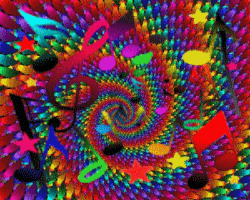
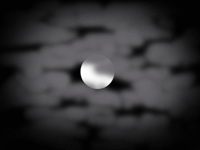

In the lonely, dead of midnight
In the dimness, of the twilight
By the streetlight, by the lamplight . . .
In the sunlight, in the daylight
And I'm workin', on the insight . . .
(Van Morrison)
.png)
Painting by Edvard Munch, "Night" (1890).
(Meme by the Gypsy Scholar.) This tongue-in-cheek meme serves to hint at how the GS has put his life style of insomnia to productive use.

"Day Surrendering Unto Night"
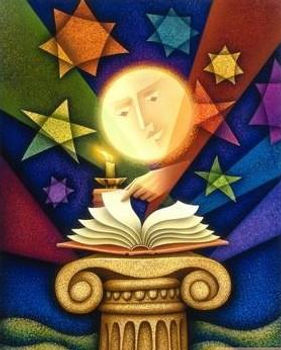

.
If you can't sleep at night and are “searching for something / something so undefined” (outside the usual formats of radio programming), then the Gypsy Scholar invites you on this radio-journey “in the middle of the night,” because “everybody knows” what you're really searching for in Radioland: “The Invisible Landscape.” So come along and let the Gypsy Scholar help you find and enter ... the Tower of Song.
The Tower of Song is the free-form radio program that creates what avant-garde media theory calls an “acoustic space”—a radio space of “auditory surrealism”—that falls in between the cracks of traditional community radio programming; in between informational and musical formats. The Gypsy Scholar’s purpose, in presenting the Orphic Essay-with-Soundtrack, is to both entertain and edify (i.e.; inform, instruct, uplift, enlighten).
The Tower of Song, then, is the “music program” deals in Ideas—that mixes and remixes Music & Ideas; ideas embedded in music and music imbued with ideas—musical ideas. Through the Orphic Essay-with-Soundtrack, the Gypsy Scholar attempts to evoke ideas that resonate with music and, conversely, play music that under-stands ideas. In this sense, the Tower of Song program fulfills the ideal of a radio program: it's mentally stimulating and emotionally satisfying and, therefore, unites the mind and the heart. The Tower of Song is, then, the “music program” of Argument & Song whose “Musical Philosophy” means that it doesn't just play songs; it showcases songs.
.

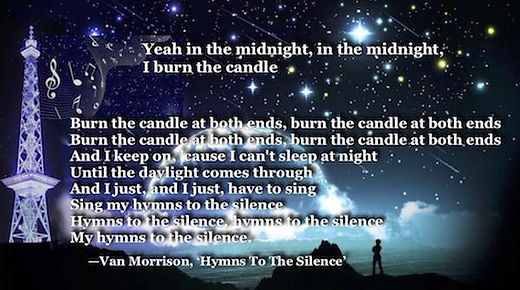
.
Gypsy Scholar's radio promos
.
.
.
Scholarship As Performance Art
.

.
Scholarship as Performance-Art
What are the Gypsy Scholar's programs?
"Are they any other than mental studies and performances?" ~William Blake
Because (Platonic) Philosophy is (as admitted by Plato) a form of “play”—an artistic endeavor—, it has the possibility to make the scholar of philosophy a kind of artist-musician; an "Orphic Scholar," who is distinguished by his or her ability "to play with knowledge and create a collage of ideas or intellectual mind-jazz."
The Gypsy Scholar & Bohemian Essayist discovered that he was doing "Musekal Philosophy" when he read Socrates musing that "philosophy" and "music" are one, and that "dialectic" (as practiced by Socrates) becomes song.
"Don’t we know that all of this is a prelude to the song itself, . . . the song itself that dialectic performs?" ~Socrates (Plato, Republic 532a)
Philosophically speaking, this translates into the radio medium as a performance art wherein the prose argument of the musical essay is a "prelude" (i.e., technically, a long "lead-in") "to the song itself." About the way the GS uses song in his musical essay, as it was once said of a great filmmaker:
“When he uses music, it's not a substitute for action [an interlude] but an enhancement of it.”
What the GS calls "The Romance of Orphic Scholarship" is an alternative academic modus operandi, where scholarship (not based upon the principle of "murders to dissect" [Wordsworth], thanatos, but rather upon the principle of eros) becomes a kind of imaginative mode of discourse. As one scholar-theorist has it, it contributes to a "re-enchantment of the academy."
.


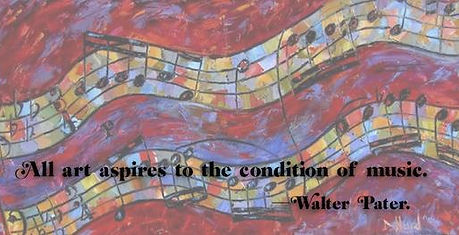
.
“The Painter's Music / The Musician's Art”
The early 20th-century painter, Wassily Kandinsky, wrote his famous theoretical work On the Spiritual in Art, in which he put forth a sophisticated color theory that associated painting with music. "The idea of music appears everywhere in Kandinsky's paintings. He believed shades resonated with each other to produce visual 'chords' and had an influence on the soul...." He also wrote play scripts which were "experiments in the synthesising of drama, words, colour and music into a single seamless whole.... To support his colour theories, Kandinsky appealed in his manifesto to the evidence of synaesthesia,
the scientific name for the condition in which the senses are confused with one another...."
.
For an article on Kandinsky's spiritual art of color and music,
.
See what I mean:
.
.jpg)
"Imagine" (John Lennon) by Melissa McCracken
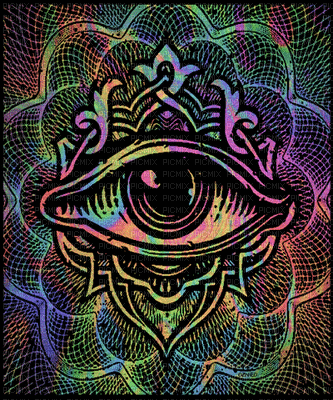

"Synesthesia and the Color of Music"
.
This artist processes songs as colors (synaesthesia) that translates into paintings inspired by her favorite musicians. To read about her and see more music paintings of this sound-artist,
For an interview with this sound-artist and to view more of sound-art,
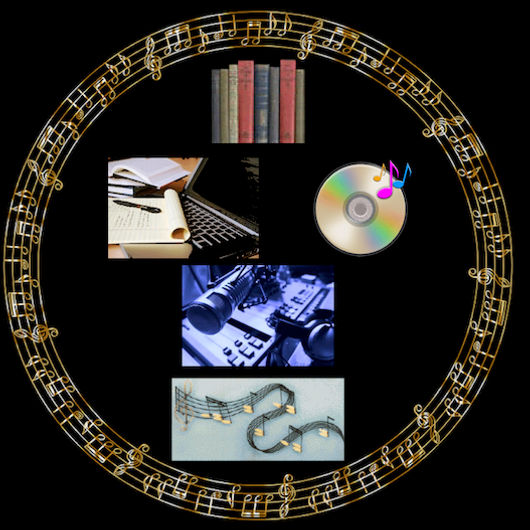
The GS's Orphic Essay-with-Soundtrack creative process
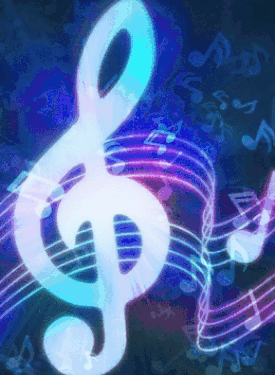




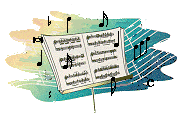








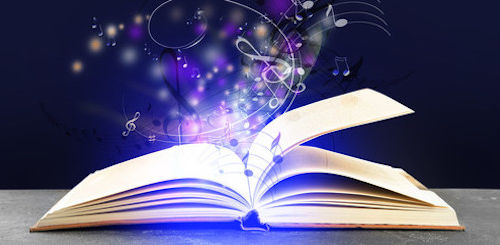

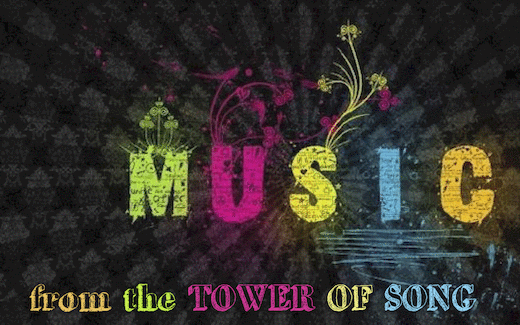


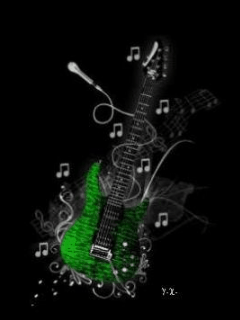


.jpg)


_j.jpg)

"The Glorification of Music"
"The Triumph of Music"


"The Muse of Music"
The Angel of Imagination & Music

"The God of Song"
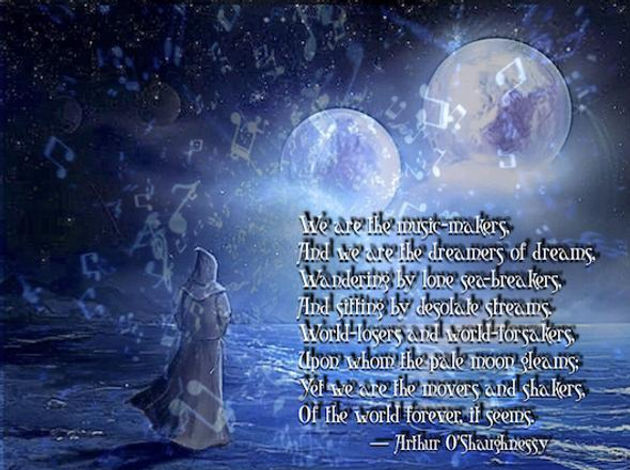



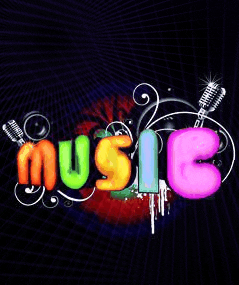
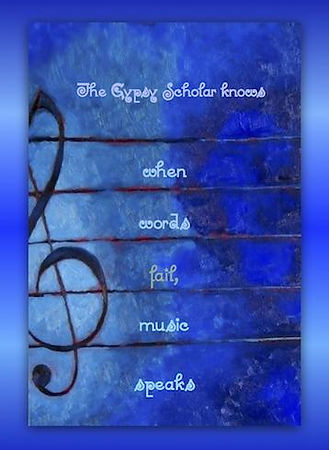
.
.

.
Re-Vision Radio’s Tower of Song program is Rhapsodic
The Greek word for “rhapsody” (rhapsoidia) comes from rhaptein (to stitch) and oide (ode, song). (Another etymology has the word from rhaptein; to sew, stitch together + aidein to sing.) In ancient Greece, a rhapsode or rhapsodist was a professional reciter or singer. Ancient scholars connected the word rhapsoidos with the poetic act of sewing (rhaptein) the poem (oide). The word rhaptein was used to describe the act of poetic composition. Thus the rhapsode was a “stitcher of songs.” The common opinion today among classical scholars is that rhapsodes were reciters of the compositions of others (such as the epic poetry of Homer), which they consigned to memory. A rhapsode’s performance could be accompanied musically by the sound of the lyre or the aulos (a wind instrument with a double reed), or it could simply be declaimed. Again, the word rhapsode is derived from the Greek (ῥαψῳδός, rhapsōidos), a reciter of epic poetry: a rhapsodist. It came to be used in Europe by the 16th century as a designation for literary forms, not only epic poems, but also for collections of miscellaneous writings and, later (as in the era of Romanticism), any extravagant expression of sentiment or feeling.
The Tower of Song Program is rhapsodic in a double sense: (a) parts of its Orphic Essay-with-Soundtrack are delivered in a heightened mode of speech or recitation (i.e., in a highly emotional utterance, in an effusively rapturous or extravagant discourse, in an effusively enthusiastic or ecstatic expression of feeling); (b) the music played out the Orphic Essay-with-Soundtrack evokes in the listener powerful feelings and emotional excitement or enthusiasm, which puts the listener in a state of overwhelming pleasure.
This characteristic of rhapsody is because of the the Gypsy Scholar & Bohemian Essayist's method of scholarship recognizes, in an age of academic postmodernism, the fragmentary nature of knowledge. Thus, the GS’s composition of the Orphic Essay-with-Soundtrack consists in stitching together bits and pieces of information and song with corresponding images in order to artistically “play with knowledge and create a collage of ideas or intellectual mind-jazz.” The GS (riffing off of the philosophical jargon of Heidegger) would say that the stitched-togetherness of scholarly composition is, at its imaginative best, rhapsodic. The rhapsodical Orphic Essay-with-Soundtrack comes out of stitching-together of Argument & Song.
.
In the best of avant-garde, academic scholarship, this style of the fragmentary and stitched-togetherness is often structured textually in the aphoristic form of writing. This is because of the broken or fragmented state of epistemology and truth. “Aphorism, the form of the mad truth, the Dionysian form…. Broken flesh, broken mind, broken speech. Truth, a broken body: fragments, or aphorisms; as opposed to systematic form or methods. 'Aphorisms, representing a knowledge broken, do invite men to inquire further …. All knowledge is particular, goes into the natural man in bits, a scrap here a scrap there'.” ~N.O. Brown, Love’s Body.
.
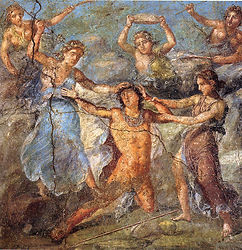
"Sparagmos" is an act of rending, tearing apart, or mangling, usually in a Dionysian context. It is associated with the Maenads or Bacchantes, the followers of Dionysus.
.
One night, the GS was listening to a radio interview with classics profressor Emily Wilson, who is the first woman to translate the ancient Greek epic story, the Odyssey by Homer, into English language. The Odyssey is a poem of a mythic quest for home, a poem about (among other things) "how we find community, how we find who gets to be in a particular community, and what does it mean that some people belong and other people don’t belong." According to Prof. Wilson, "it's a poem that resonates with current issues we have in our culture such as immigration, or what do we do about veterans returning from war." And, of course, it's a poem that James Joyce modeled his great novel, Ulysses, after.
The GS was listening to this interview because he wanted to hear about the Odyssey from a woman's perspective. However, little did he know what treasure lay waiting for him from Prof. Wilson! When asked to define and describe what an ancient Greek dramatic performer called a"rhapsode" was and how this related to our word "rhapsody," not only did she rise to the occasion by putting it in terms of modern music ("Rhapsody In Blue") but, more importantly for the GS, she pointed to the radio "DJ" as a perfect example of someone proficient in the (rhapsodic) "stitching together" of songs!
Wow, of all the possible examples Prof. Wilson could have used to convey to the layman what an ancient rhapsode (one who performed epic poems/songs for the masses) did, she came up with the DJ of popular culture!!! Thus, the GS couldn't help but feel that this stunning synchronicity was meant for him. (Hence the memes that follow. Listen to Prof. Emily Wilson below.)
.
.





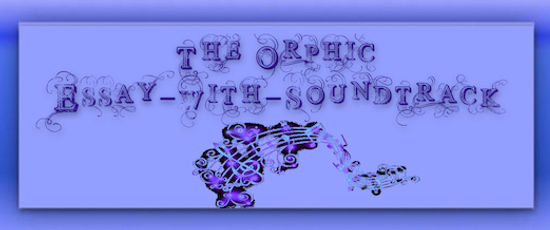
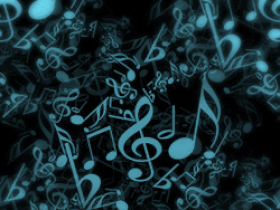

.
.
The Tower of Song—“not for everyone, but for madmen only”—is the radio program that puts its philosophy best in song—and, just maybe, puts you into the Tower of Song, where “only the right guests meet.”
“‘What luck,’ I said, ‘to find myself here with you today!’ ‘Nothing ever happens by chance,’ he answered. ‘Here only the right guests meet. This is the Hermetic Circle.’” (Herman Hesse interview, 1961)
And about a radio program that's “not for everyone, but for madmen only,” it should be known that the Gypsy Scholar isn’t trying to do a program that will please everybody, but instead a program that creates its own unique niche of an audience.
“The present and the future are about getting a very loyal tribe on your side. I think this idea of being everything to everybody is a sort of old fashioned idea.” —Daryl Hall (of Hall & Oates, “Live from Daryl's House,” 10/15/11)
.

--Jacob Nordby

.
Given that the Gypsy Scholar & Bohemian Essayist (as intellectual outsider) is in exile from the Ivory Tower and has moved to "that tower down the track"--the Tower of Song--, he stands outside the other dominator institutions of church and state, and thus stands with the "Romantic Outsiders" of history; on the side of the popular (outside academia), the profane (outside the temple) and the outlaw (outside the state)--taking his stand (as a "public intellectual" on radio) on the side of "Always Lost," the "Beautiful Losers" (the bohemian "Beats"), who carry on the eternal "Mental Fight."
"Rouze Up, Oh Young People of the New Age! Set your foreheads against the ignorant Hirelings! For we have Hirelings in the Camp, the Court, & the University, who would, if they could, forever depress Mental & prolong Corporeal War." ~William Blake
.
The experimental format of Re-Vision Radio’s Tower of Song program—a “freeform” radio format—is a seamless remixing of Argument & Song; dialectics & music, or logos & mythos. In other words, philosophical-literary essays are put to music, producing the Orphic Essay-with-Soundtrack. Thus, since there’s a song hermetically hidden in an essay and, conversely, an essay waiting to be revealed in a song, Re-Vision Radio puts its philosophy best in song. As the lyric goes: “That’s why I’m telling you in song.” [Van Morrison]
This dialectical intertextuality creates a novel radio art-form: scholarship as performance art (Cf. William Blake’s “Mental Studies & Performances”), which is a Romantic way to “associate ideas in a state of excitement” [Wordsworth] and to “rave on words on printed page.” [Van Morrison] Re-Vision Radio’s musical intertextuality, because it reads metaphorically between the lines of Argument & Song, becomes the imaginal hyper-textuality of a “radio-text,” or Soul-text—a soul-inflected montage of spoken word, music, and image, which opens the listener up to synaesthesia.
Re-Vision Radio’s Orphic Essay-with-Soundtrack, assaying back and forth—with seamless segues—between high academic culture (argument) and low pop-culture (song), takes its cue from the great Romantic composer, Beethoven, who, it is said, “took great delight in juxtaposing the exalted and the commonplace,” making his music “a union of sensuous and rational.”
In mixing and remixing Argument & Song—mixing logos and mythos—through its Orphic Essay-with-Soundtrack, Re-Vision Radio seeks to conjure up what media theorists call an “acoustic space;” an Orphic soundscape, an eclectic medley of the esoteric and the popular, high academic culture and low pop-culture—high argument & deep song—, not from the Ivory Tower, but from “that tower down the track:” And because the Orphic Essay-with-Soundtrack utilizes folk-rock and rock music of pop-culture in order to bring together the Ivory Tower and that “tower down the track” (i.e., high academic culture and low pop-culture), it especially takes its cue from the great American “Orphic Scholar,” Ralph Waldo Emerson, who dared to proclaim: “I embrace the common, I explore and sit at the feet of the familiar, the low.”
(from the “Re-Vision Radio Manifesto and Visionary Recital ”)
.

.
The Sixties Passion for (non-commercial) "Underground" FM Radio
.



.

Turn up your radio and let me hear the song
Turn it up, turn it up, little bit higher, radio
Turn it up, that's enough, so you know it's got soul
Radio, radio turn it up, hum
La, la, la, la ....
(Van Morrison)
And the music on the radio,
And the music on the radio
Has so much soul, has so much soul
And you listen, in the nighttime
While we're still and quiet
And you look out on the water
And the big ships, and the big boats
Came on sailing by, by, by, by
And you felt so good, and I felt so good
Felt so good
Felt so good ....
(Van Morrison)
.
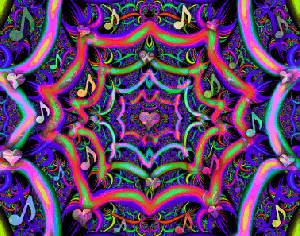
.
Free-Form Radio DJs on their medium
I held the medium itself in a kind of sacred regard…. It was a wondrous time of learning and adventure without restriction, a time of total freedom on the air…. Once you tapped into the muse, you could play your radio show like an instrument. You could make your own music, choose just the right tune to strike a specific chord, find that certain combination of lyrics that tied the songs together in a thematic way…” —DJ Jim Ladd, Radio Waves
“When I talk to people, they tell me that they feel us inside of them. It’s not that they listen to us on radio. They feel us inside!” —DJ M’banna Kantako
“I love to be surprised. I got into radio because I have a passion for music and ideas, and celebrating what connects us. We need things that feed our souls. Let's hope this format is broad enough to encompass what we love.” (KUSP programmer, 7/2016)
Listen Mr. DJ
Won't you play me something slow
Play me the songs
For the lonely ones
Play me something
That I know.
Hey Mr. DJ
I'm in a sad mood tonight
Play me something just for me and my baby
Won't you make everything alright.
I'm gonna turn it way down low
Leave it on all night long
Till the morning comes
Like my lover my friend until the end
And that special someone ...
Well, Mr. DJ
I'm in a sad mood tonight
Play me something for me and my darling
Want you to make everything
Alright ...
On the radio
On the radio
On the radio
Uh-uh, all right
Uh-uh, all right....
(Van Morrison)
.


.
The first two sentiments from underground radio DJs (and many others like them), are sources of inspiration for the Gypsy Scholar. The last sentiment (which is recent) could perfectly apply to the Tower of Song (formerly a KUSP program) — a program about “music and ideas” and “things that feed our souls”!
.





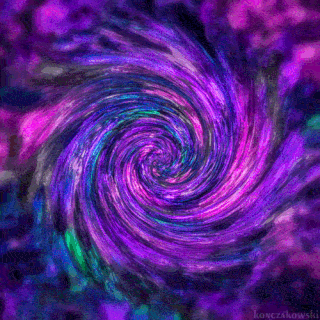
%201.png)
.

.


Tower of Song Broadcast & Website Synergy
Synergy: the interaction or cooperation of two or more organizations, substances, or other agents to produce a combined effect greater than the sum of their separate effects.
The relationship between the Tower of Song's radio broadcast and the Tower of Song's cyberspace website: they are integral parts of one another; they are synergistic.
Although the Gypsy Scholar's radio program was on the air well before the interlinking of radio with the internet, it is nonetheless true that the program’s experimental and novel format of mixing the spoken word with music logically lends itself to the innovational nature of the new internet webcasting media. The innovation for the Tower of Song radio program is in fact the interlinking of the spoken word (as cyberspace “radio-text”) and the visual image. Thus, the Tower of Song’s modus operandi, the “Orphic Essay-with-Soundtrack,” which mixes the spoken word with music (i.e., “Argument & Song”), is enhanced with the thematic image.
This is the reason the Gypsy Scholar can introduce the program thusly: “If you go to the Tower of Song website, you can see what I mean by the Tower of Song—both conceptually through the ideas and visually through the images.” This means that the synergistic interaction of the Tower of Song’s radio broadcast and its website are designed to ideally produce a synaesthetic experience (i.e., a concomitant sensation of two senses—sound and sight). The audio-visual component of the Tower of Song enhances the overall radio experience. This is one part of the reason why the Gypsy Scholar calls the concept behind his experimental, free-form program format “Re-VisionRadio” (which denotes the double meaning of seeing the communicative medium of radio in a different way and also actually seeing radio—“imaging”).
Therefore, with the conjunction of word and image (and let us not forget that early on radio was referred to as “Theater of the Imagination”), the Gypsy Scholar can say that the Tower of Song program traffics in imaginal ideas, which (unlike strictly analytical, abstract ideas) do not leave out the feeling function of the psyche (which is said by depth-psychologists to be made up of essentially “images”), but instead appeal to both head (“argument” or logos) and heart (“song” or mythos), and thus imaginal ideas have the possibility of uniting the two great contrary principles of Western epistemology—mythos and logos. And when this application of imaginal ideas is consistently applied in an artful way—through the mixing and remixing of Argument & Song—it has been the Gypsy Scholar's experience that what sometimes happens on the Tower of Song program is a dialectical inversion of the usual head and heart functions. As the song goes (about the origins of Western philosophy with Socrates and Plato): “If my heart could do my thinking / And my head begin to feel / I would look upon the world anew / And know what's truly real.” (Van Morrison)


Again, because synergy represents a dynamic process in which a joint action issues in a total effect that is greater than the sum of effects when acting independently, this means that for Tower of Song program—which is about basically about communicating Ideas in a musical format—the synergy of radio and website issues in an central idea or motif expressed in the simultaneity of song and image. So the knowledge-based format of the “music program” (a format that falls between the cracks of traditional radio programing of either information or music) is actually that of a lyrical knowledge, which is communicated by teasing out big ideas embedded popular song—songs that punctuate, condense, or sum up an essay and, conversely, essays that unpack songs.
.
The three images here all represent the concept of Synergy.
.
.

“Philosophy, which has always been the pursuit of my life, and is the noblest and best [highest] form of music.” —Socrates/Plato, Phaedo
“Oh, Socrates and Plato / Praised it to the skies / Everyone that ever loved / Everyone that ever tried.” —Van Morrison, “I Forgot That Love Existed”
“Music is philosophy. Every chord, every word tells a story. If you listen, you will know its meaning.” —Kamanda Nduma
“Re-Vision Radio's Tower of Song is a Musical & Philosophical-Literary program. (“Re-Vision Radio Manifesto Visionary Recital”) .... The Tower of Song is a program dedicated to the “life of the mind.” Thus, it’s about Ideas; the ideas in the music and, conversely, the music in the ideas—a Musekal Philosophy.”
Because the Gypsy Scholar opens his “Radio Manifesto” in this way, despite the fact that the Gypsy Scholar doesn’t build his program around standard “philosophical” topics, nor does he make it a practice to present listeners with the works of recognized “philosophers,” he feels obligated to explain in what sense is the Tower of Song program—a “music” program—“Philosophical.”
The Gypsy Scholar will present here the viewpoints from different academic philosophers concerning the place of “philosophy” in the world at large outside the halls of the academy, in order to justify describing his music program as a “philosophical” one. However, speaking for himself, the GS can say that calling his “music” program “philosophical ” probably has a lot to do with the fact that his own academic background earned him an advanced degree in “Religion and Philosophy,” and so he has always had this kind of orientation to life.
Philosophy For The Masses & The National Love Affair With Philosophy
.
VAMPIRE SQUID MASCOT


File under KSQD's "Cephalopod week fun fact."

The Vampire Squid (Vampyroteuthis infernalis, “Vampire squid from Hell”) does not suck or drink blood, but instead gets its vampire name from its dark color and the skin that connects the arms, resembling a cape. It’s a small cephalopod found throughout temperate and tropical oceans in extreme deep sea conditions (the mesopelagic zone), from 2000 to 3000 or more ft. It has 8 arms and 2 tentacles. This species lives in the nearly completely dark waters. Its body is almost entirely covered in bioluminescent organs. Its unique oxygen metabolism allows it to thrive in the parts of the ocean with the lowest concentrations of oxygen.
Dr. David Gallo, an oceanographer and Director of Special Projects at the Woods Hole Oceanographic Institution, describes the characteristics of this denizen of the infernal deeps: “Vampyroteuthis infernalis, the vampire squid—incredibly cool! In the darkness of the deep sea he’s got glowing tentacles. So, if I’m coming at you, like him, I put my arms out in the darkness so that all you see are these glowing things over here and in the meantime I’m coming at you. When he wants to escape, he’s got these glowing pods on his butt that look like eyes; he’s got glowing eyes on his butt—man, how cool is that? It’s just an amazing animal! Vampire squid, because when it gets protective it pulls this black cape over its whole body and curls up into a ball. Outrageous animal!”
The “Vampire Squid,” as a new mascot for the Gypsy Scholar, perfectly fits what our Board Chair and programmer, Rachael Anne Goodman, quipped about while on the air during the celebration the KSQD 3rd Birthday (2/15/22), with special interviews with the late-night music show hosts: “... the late-night people, who don’t usually come out during the light of day!” (The GS had already considered the “Vampire Squid” as his new radio mascot, but this cinched it!)
Because everyone at the station enjoys making up puns about “squids” and the radio station (e.g., “the new squid on the block”), the Gypsy Scholar came up (along with “that tower down the track”— located in “Squid Row”) with the “Vampire Squid” as his unique K-Squid mascot.
The Gypsy Scholar chose the “Vampire Squid” for his mascot because of his late-night program for night owls and the habitual insomnia that makes it possible. (As the Tower of Song theme-song goes: “In the middle of the night / I go walking in my sleep ....” ~ Billy Joel, “River of Dreams.” As the Tower of Song promo goes: “Yeah in the midnight, in the midnight, / I burn the candle / Burn the candle at both ends, burn the candle at both ends / Burn the candle at both ends, burn the candle at both ends / And I keep on, 'cause I can't sleep at night / Until the daylight comes through / And I just, and I just, have to sing....” ~Van Morrison, “Hymns to the Silence.” As Leonard Cohen once quipped, “The last refuge of the insomniac is a sense of superiority to the sleeping world.”)
Also, significantly enough, the Latin classification of the “Vampire Squid” as Vampyroteuthis infernalis (“Vampire Squid from Hell;” Hades or the Unconscious) coincides with the Gypsy Scholar presenting musical essays on an alternative spiritual path in the New Age paradigm—the via negativa of “Dark Romanticism,” which he calls (in Latin) a Desensus ad inferos (“descent into the infernal region,” or the Underworld).
Therefore, the “Vampire Squid” as the Gypsy Scholar's K-squid mascot, represents his commitment to the depths—the depths of Soul.
“‘Depth psychology,’ the modern field whose interest is the unconscious levels of the psyche—that is, the deeper meanings of the soul—is itself no modern term. ‘Depth’ reverberates with significance, echoing one of the first philosophers of antiquity. All depth psychology has already been summed up by this fragment of Heraclitus: ‘You could not discover the limits of the soul (psyche), even if you traveled every road to do so; such is the depth (bathun) of its meaning (logos).’ Ever since Heraclitus brought soul and depth together in one formulation, the dimension of soul is depth (not breadth or height) and the dimension of our soul travel is downward.” ~ Dr. James Hillman
Wow, we're definitely in deep waters (of the soul) here! The “Vampire Squid”—that denizen of the infernal depths—serves to show that one can descend into the watery, dark abyss (i.e., the Underworld or the Unconscious Psyche) and be at home there, having developed own's own oxygen (pneuma: the vital spirit, soul, or creative force of a person) to breathe and own's own light to see with. (However, the analogy stops there—the GS, in this anal-ogy, doesn't have “glowing eyes on his butt”!)
So, about the “Vampire Squid,” the Gypsy Scholar can't resist one more pun:
Here's looking at you squid !


